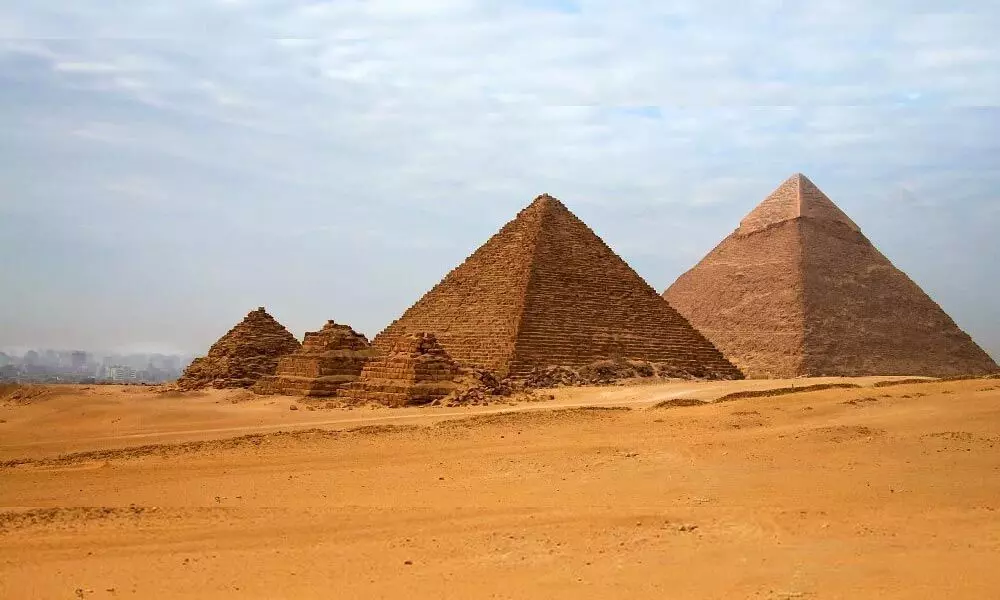Live
- India among top 10 countries with AI readiness: Report
- UNICEF to support Kerala's children with special needs
- Meta purges over 2 million accounts linked to scam centres
- Mumbai, Delhi ranked among top 5 prime residential markets in Asia-Pacific
- Russia provided North Korea with anti-air missiles in exchange for troop deployment
- PCB appoints Azhar Ali as head of youth development
- Deepam-2 Scheme Reaches 5 Million Beneficiaries in Three Weeks, says Nadendla Manohar
- Will RG Kar tragedy impact Bengal bypoll results?
- BGT 2024:25: Josh Hazlewood picks four as Australia bundle out India for 150
- BRS rallies support for Lagacharla ‘victims’
Just In
Researcher May Have Decoded The Mystery Of The Alignment of the Pyramids


Researcher May Have Decoded The Mystery Of The Alignment of the Pyramids (Photo/sciencealert)
- The question that arises is how the structures get so perfectly aligned is one of the most perplexing concerns.
- The square sides of the 138.8 metre, Great Pyramid of Giza which is also referred as the Great Pyramid of Khufu are almost precisely aligned along the cardinal points
The Giza pyramids have baffled academics for years, not just because of their mysterious holes and hidden chambers, but also because of how ancient Egyptians built such massive structures without modern technology. The question that arises is how the structures get so perfectly aligned is one of the most perplexing concerns.
The square sides of the 138.8 metre, Great Pyramid of Giza which is also referred as the Great Pyramid of Khufu are almost precisely aligned along the cardinal points, north-south-east-west, despite being slightly uneven.
Glen Dash, archaeologist and engineer explained in a study published in 2017 in his journal that the Great Pyramid of Khufu was aligned to the cardinal points with an accuracy of greater than four minutes of arc, or one-fifteenth of a degree, by the builders. Dash noted that all three pyramids exhibit the same type of error: they are rotated slightly counterclockwise from the cardinal points.
In fact, all three of Egypt's tallest pyramids - two at Giza and one at Dahshur – are remarkably aligned in a way that you wouldn't anticipate from a time before drones, blueprints, and computers. While various theories persist as to how they did it – such as using the pole star to align the pyramids or the Sun's shadow - no one knows for sure.
Dash came up with a new, more straightforward notion. According to his research, the Egyptians might have used the autumnal equinox to achieve perfect alignment some 4,500 years ago.
The equinox occurs twice a year when the plane of the Earth's equator moves across the centre of the Sun's disc, and the length of day and night is almost equal.
Previously, equinox measurements were dismissed as a feasible alignment approach because they were thought to be insufficiently precise.
However, Dash's research revealed that there was a means to make this work: a gnomon rod. Dash conducted his own experiment to determine this, beginning on the first day of the fall equinox in 2016 – September 22 – and casting a shadow with a gnomon.
He followed the shadow's tip at regular intervals, creating a smooth arc of points. At the end of the day, he intersected two of the curve's points with a taut piece of string wound around the pole, creating an almost perfect east-west line.
He also demonstrated that the degree of fault is slightly counterclockwise, comparable to the minor error observed in the alignment of Giza's Khufu and Khafre pyramids, as well as Dahshur's Red pyramid.
Dash conducted his own experiment to determine this, beginning on the first day of the fall equinox in 2016 – September 22 – and casting a shadow with a gnomon.
He followed the shadow's tip at regular intervals, creating a smooth arc of points. At the end of the day, he intersected two of the curve's points with a taut piece of string wound around the pole, creating an almost perfect east-west line.
He also demonstrated that the degree of fault is significantly centrifugal, comparable to the minor error observed in the alignment of Giza's Khufu and Khafre pyramids, as well as Dahshur's Red pyramid.
According to him, the Egyptians would have been able to calculate the fall equinox by counting 91 days forward from the summer solstice.
However, while his article suggests that this approach could have been employed to align the pyramids, there is no substantial evidence that this was the case.

© 2024 Hyderabad Media House Limited/The Hans India. All rights reserved. Powered by hocalwire.com






